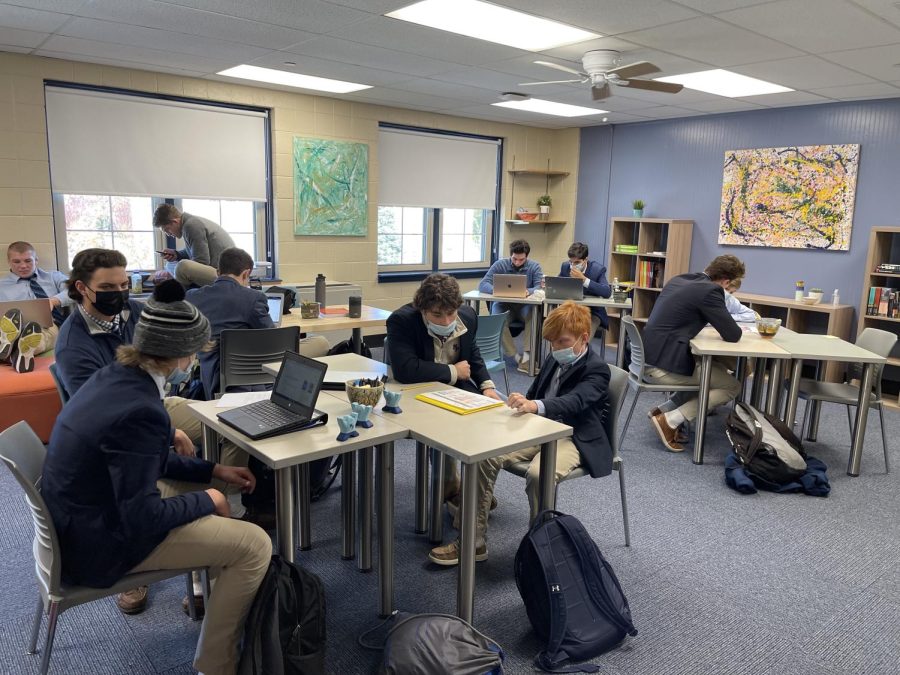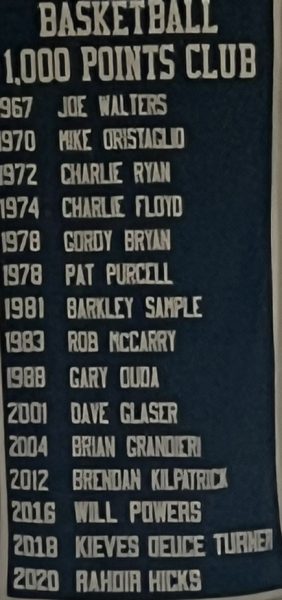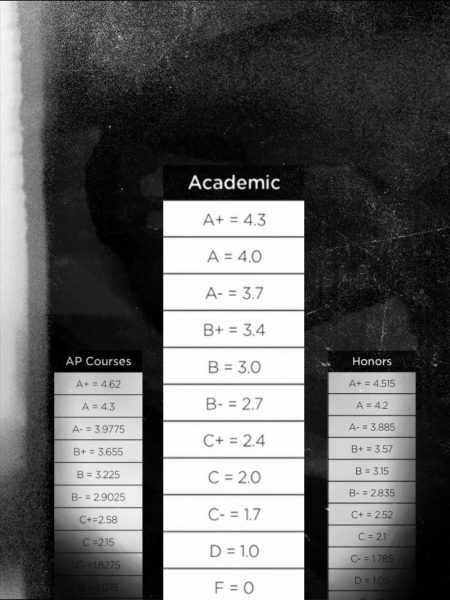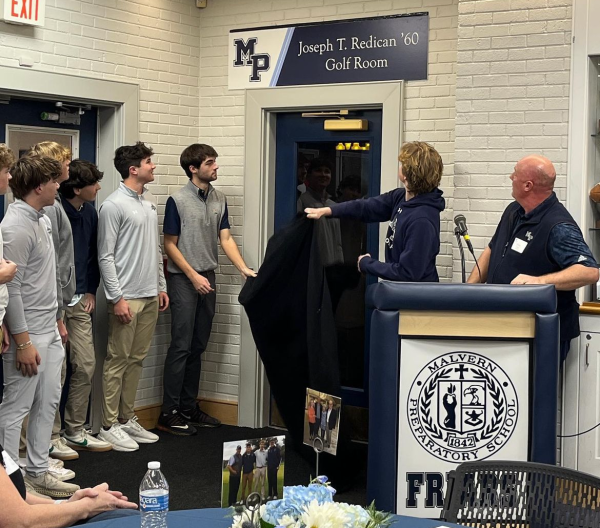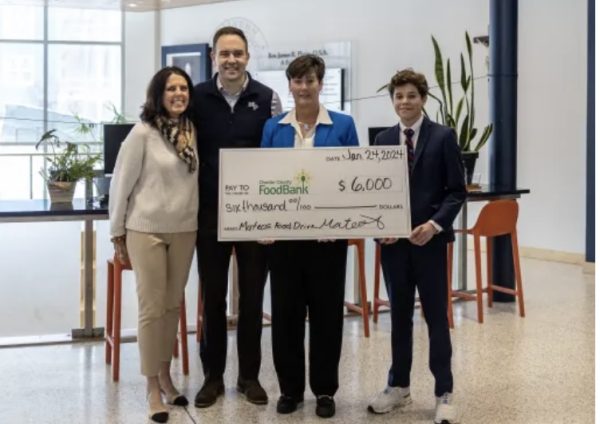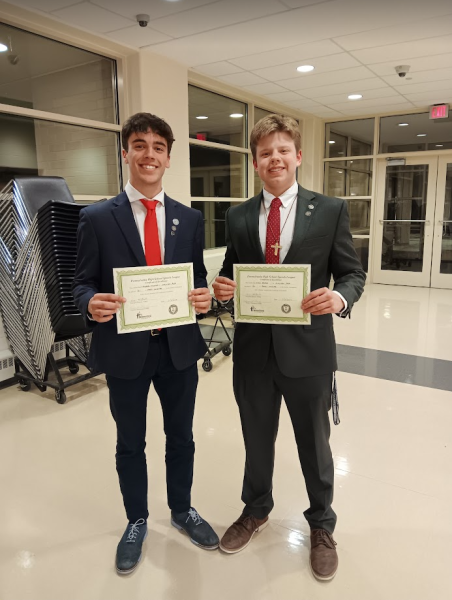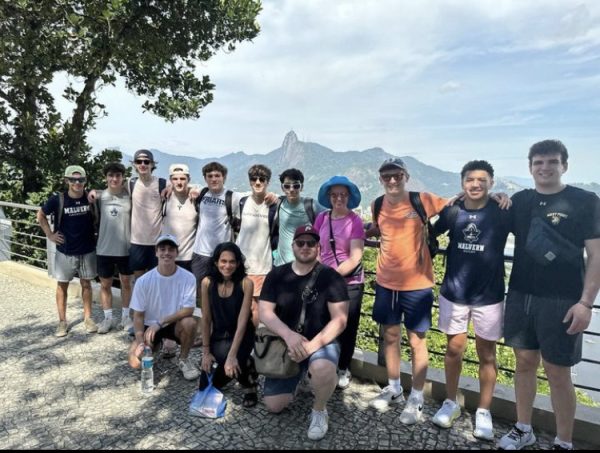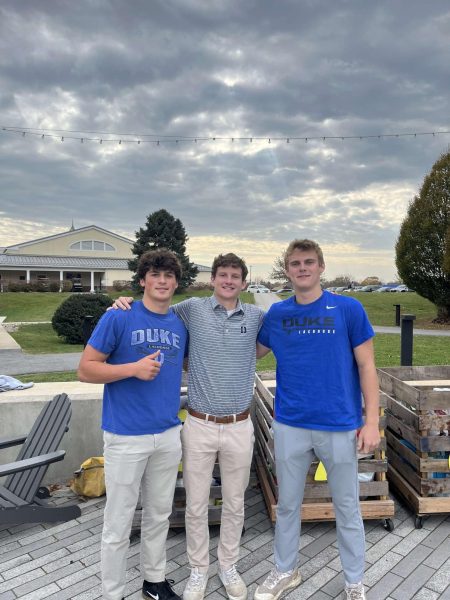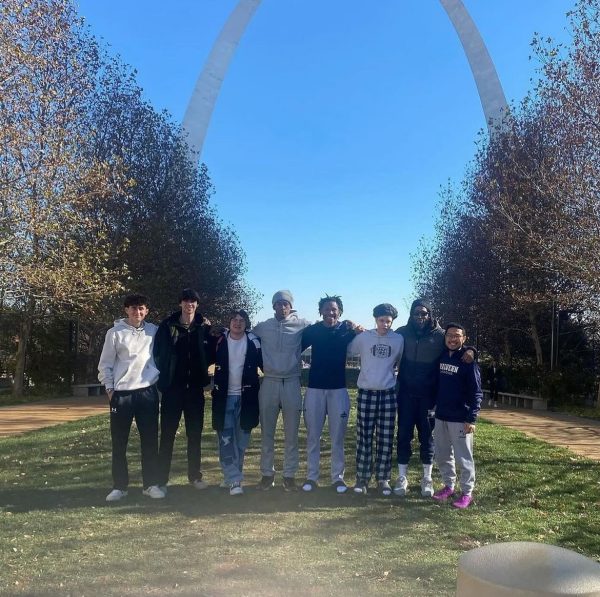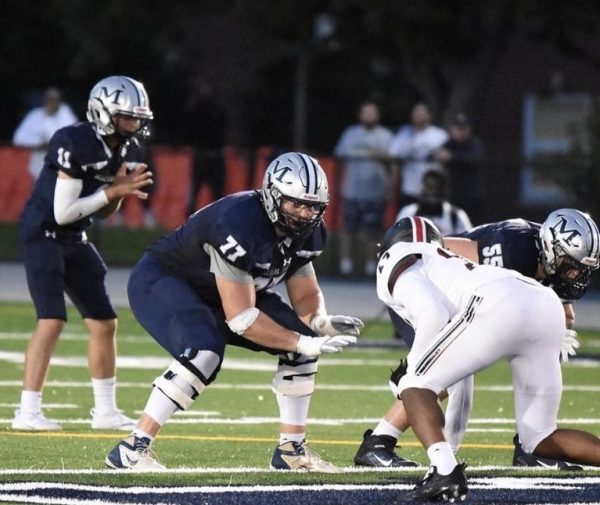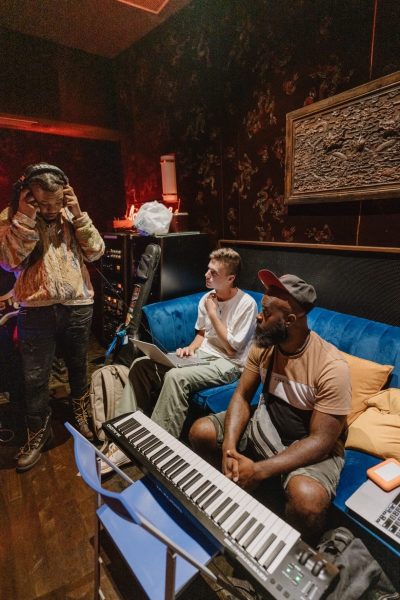Peer-to-Peer Learning Center Shines on Campus
With the Peer-to-Peer Learning Center officially opened, high schoolers and middle schoolers alike can utilize the space for their academic benefit.
What began as a Writing Center last year has turned into a school-wide space for all different subjects.
Mrs. Susie Sweeney-Berlacher, Friar’s Lantern moderator and Upper School Curriculum Coordinator for English, is the founder of the Peer-to-Peer Learning Center and has spent years creating the program.
Assisting Sweeney in the development and facilitation of the learning center is Mrs. Korin Folan, Upper School counselor, who has been working with Sweeney on the project for about a year.
“Over the summer, Ms. Sweeney and I partnered together and worked on a curriculum where students who would like to participate in the Peer-to-Peer Learning Center could become a tutor by going through the training so that everybody has the same training,” Folan said.
Sweeney’s idea to bring a learning center to Malvern initially began a few years ago, but it wasn’t until the 2020-2021 school year that she was able to bring a smaller-sized Writing Center to the school.
“A few years ago, I had a group of students struggling to learn a complicated writing concept. However, there were twenty students who needed to ask questions and only one of me,” Sweeney said. “The next day, I asked two teachers to assist in my classroom. In one hour we were able to teach the concept by working individually with each student.”
Having the extra help in her classroom, Sweeney realized her students were able to better understand the material.
“After this class, I noticed how students were working with friends in the hallways or Stewart Hall and essentially teaching their friends concepts or helping them before quizzes. I thought to myself: wouldn’t it be amazing if I could have older students help in my classroom?” she said.
Now with a new idea in mind, Sweeney got to work.
“That summer I started working on the earned Honors Writing Seminar course because I knew that a learning center would only work if students were trained how to tutor and educate,” she said.
The Writing Seminar course is a stepping stone into the Peer-to-Peer Learning Center. Although the course is not required to become a tutor, Sweeney feels it is a great benefit to those who are interested.
“I created the Writing Seminar course to teach students how to think like a reader, write like a writer, and teach like a teacher. When you are constantly tutoring students, using your knowledge as a writer, evaluating what teaching and studying methods work and don’t work, your knowledge is only going to improve as you learn through the tutoring process,” she said.
While last year’s tutors focused more on working with middle school English students as opposed to the entire Upper School, Sweeney recognizes the influence her tutors had on the expansion of the tutoring program.
“Thanks to my inaugural class of Writing Tutors, our first year was strong, which allowed Mrs. Folan and I to expand,” Sweeney said. “I started working with Mrs. Folan this [past] summer to create The Peer to Peer Learning Center tutor training program so we could branch into other subjects as well,” Sweeney said. “We realized that a lot of programs and honors societies on campus try to offer tutoring and this can get confusing for students.”
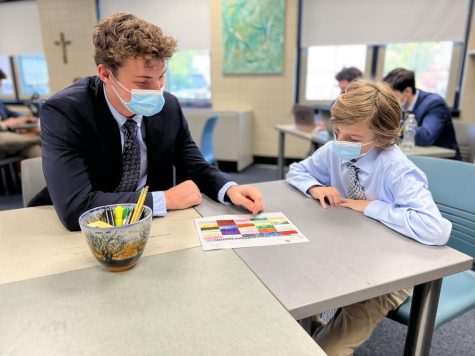
The expansion of the tutoring program hopes to allow all students from grades six through twelve to get tutored by students who have excelled in both commitment and understanding of different subject areas offered on campus.
Having more tutors and resources available this year, Sweeney knew they needed a location to call home for the learning center, to house all of the tutoring sessions, and keep it in one central location.
“After we were approved to expand, Mr. Sillup was instrumental in helping us create a space where we could hold tutoring sessions,” Sweeney said.
Mr. Patrick Sillup, Assistant Head of School for Academics, assisted Sweeney and Folan in the creation of the learning center space on campus and helped secure and plan out a conducive environment.
“We had some fabulous exchanges with upperclassmen and eighth grade English [students], and we had some wonderful experiences within Ms. Sweeney’s Writing Seminar course. So much so, we got to a point where we said look, the Google Hangouts were great, utilizing the main floor of the Saint Augustine Center was wonderful, but we really need our own space,” Sillup said.
To achieve the maximum effectiveness of the learning center, there needed to be a select place on campus specifically for this use.
“When the Dean of Students Office was going to move to St. Rita’s, there was one little spot in the top of Carney and we said well, could this be an opportunity for that to be that space,” Sillup said.
“The Learning Center is located on the third floor of Carney and is used for collaborative learning and quiet study,” Sweeney said. “This space is also designed by students, with help from Ms. White and Ms. Lee, and I love the environment the Art and Ceramics students have created; we still have more work to do, but I love the potential this space offers.”
Along with the artwork by Malvern students hanging on the walls and ceramic containers filled with pencils and classroom materials, there will be a handmade ceramic installation leading up to the learning center.
Ms. Kat Lee, Upper School visual arts and ceramics teacher, is helping to oversee her ceramics students’ project for the space. Lee mentioned that her advanced ceramics classes are required to complete a service project that ties into the values of the school; the Peer-to-Peer Learning Center art installation will serve as this year’s service project.
“Patrick Rooney ‘22 and Luke Gueriera ‘22, are my two Ceramics IV students who are taking on this endeavor and it is a mosaic, essentially, that will cover the face of about eight steps that lead up to the learning center,” Lee said. “The students designed it, proposed it, got acknowledgement and the okay for it, and they’re doing everything for the project.”
At the beginning of the school year, while the center was being planned and designed, Sweeney and Folan were able to gather students from the different honors societies on campus that would serve as the tutors for the Peer-to-Peer Learning Center.
“With the help of Ms. Suber, Mrs. Cox, and Mrs. Krause, we were able to train over forty-five tutors this September and have the ability to tutor across most curriculums; writing, math, science, Spanish, Latin, and Chinese,” Sweeney said.
Having a centralized tutoring program can provide students with the continuity necessary to receive the help they need.
Mrs. Francine Cox, Upper School Learning Specialist, and Mrs. Kim Krause, Middle School Learning Specialist, helped train the tutors in September on neurodiversity and learning strategies in preparation for their tutoring sessions. Both Cox and Krause plan to continue offering their support and assistance to the tutors helping with the learning center
“I’m hoping to work pretty closely with the tutors and make sure that having them be able to use me as a resource, but also guide them like ‘hey this little guy really needs help on vocab, so let’s use this session, and give them some strategies about how best support the students,’” Krause said.
Many of the tutors work closely with the middle schoolers, helping them with their essays and classes, something Krause feels will be a huge benefit for the younger students.
“The little guys love having connections with the upper schoolers, so I think it’s kind of a win-win for everyone,” Krause said.
Middle school English teacher, Ms. Metty Vithayathil, worked closely with Sweeney and the tutors in her classes last year. The tutors would come into her classes and occasionally assist her students with their papers.
“I would say that one of the messages that I try to convey to the students is that good writing requires significant editing, and I think what we were able to do with the writing center and working with the eight grade writers to sort of slow down the process for them to see that the more times they went back to read their writing, the better they can see the improvements,” Vithayathil said.
In addition to the tutors working in the Peer-to-Peer Learning Center, tutors will also have the ability to go into classrooms and assist teachers working one-on-one with students.
“To have an upper school student look at that with you is just invaluable and the amount of time students spent with the eighth-graders, I wouldn’t have enough time in my day to provide that one-on-one system,” Vithayathil said.
Given that teachers have busy schedules, similar to students, it can be hard to provide undivided support to students whenever they may need it.
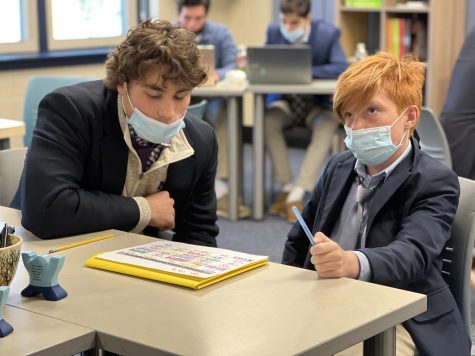
“I feel like the extra support, particularly for freshmen who are adjusting to high school, is going to be wonderful. I also feel like coming into the classroom is a phenomenal idea, because I don’t have enough time to get into the classroom, so I think that will help a lot,” Cox said
With the learning center expanding its audience this school year, other teachers, honors societies, and members of the community have been able to take part in the impact on campus.
Mrs. Diane Giordano, Mathematics Curriculum Coordinator, is excited about the new Peer-to-Peer Learning Center and looks forward to the success she believes it will bring to her students.
“The Peer-to-Peer Learning Center is such a great opportunity for the students at Malvern. If a student is struggling with a topic, he can meet with a peer tutor and work through the content,” Giordano said. “The student’s confidence may increase when he works one-to-one with someone close in age to him, someone who understands the daily struggles of a student today,” she said.
Spanish Honors Society Moderator, Mrs. Kim Wright, will be assisting with the Spanish peer tutors and their involvement in the learning center.
“I think the biggest benefit to having tutors is that they’re there, and you don’t have to try to figure out where to go for help,” Wright said.
In regards to the language department, there are many upperclassmen well versed in the particular languages which offer them the opportunity to help those struggling.
“I can see some of my upperclassmen, like my senior or junior students helping freshmen or sophomores practice conversation skills. If they have an interview type assessment coming up, but also doing worksheets or conjugating or doing any kind of practice with the language,” Wright said.
Mrs. Anna Geider and Dr. Agnese Abate, Science National Honors Society (SNHS) moderators, are both looking forward to the SNHS members’ involvement in the learning center and the continuity it will provide students.
“We are very excited about this opportunity because we actually needed some structure on the tutoring sessions,” Abate said. “The tutors can really develop a skill that is actually required for teaching, and if you learn that skill, you can use it when you’re finishing high school and going to college, so it’s actually a good skill to have.”
The peer-to-peer nature of the center, Abate feels, can offer students a more personal and relatable experience, contrary to that which a teacher can offer.
“For the students who were tutored, it’s actually an advantage, because instead of having the teacher repeating the same thing over and over, they can meet their peers, who are the same level of language and knowledge, so they can understand where the struggle is,” Abate said. “The tutors can put themselves in the shoes of the students and say well, ‘I struggled too when I learned this, that’s why you’re struggling now I can help you with this,’” she said.
Current peer tutor Stephen Hollander ‘22, who took Sweeney’s Writing Seminar course last year, can attest that the challenges he faced as a younger student, enabled him to better understand what the students were going through and how he could help.
“Working with the Peer-to-Peer Learning Center last year was a phenomenal experience. Knowing when I was in middle school and eighth grade that writing didn’t come easy to me, being able to give back and help out students that shared a similar struggle as I did during that age was pretty cool,” Hollander said.
Even Father Donald Reilly, Head of School, agrees that having students give back to one another in the form of tutoring not only connects to the school theme for the current academic year, but creates a wonderful bond between the tutor and student.
“Student tutors can embody the theme “To lead is to serve and To serve is to Love” by elevating the experience of being with a fellow student as a companion on the journey…a co-learner, a fellow seeker of knowledge. If the tutor and tutee share a passion for learning, both advance in knowledge, and their time together is mutually beneficial,” Reilly said.


